CIMMYT E-News, vol 5 no. 10, October 2008
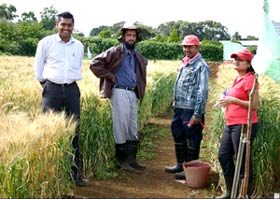 As the price of wheat goes up, countries such as the Republic of Mauritius are feeling the pinch. A former British colony off the coast of Madagascar, it imports most of its wheat from France and Australia. But with help from CIMMYT, the island has started trials to grow its own wheat—and results to date look promising.
As the price of wheat goes up, countries such as the Republic of Mauritius are feeling the pinch. A former British colony off the coast of Madagascar, it imports most of its wheat from France and Australia. But with help from CIMMYT, the island has started trials to grow its own wheat—and results to date look promising.
The CIMMYT germplasm bank freely distributes maize and wheat seed to hundreds of partners worldwide each year. In January 2008, Tom Payne, Head of CIMMYT’s wheat germplasm bank (seed bank), received a request for wheat seed from Mala Gungadurdoss, Head of the Mauritanian Agronomy Department at the Ministry of Agro-industry. “The rising price of imported wheat coupled with a scarcity on the international market (made us) revisit our food and agricultural policy,” explains Gungadurdoss, who is also Principle Research Scientist of the Agricultural Research and Extension Unit. “Our food security is at stake, since Mauritius imports most of its staples.”
Payne sent a “yield trial” of 49 elite spring wheat lines that he thought might flourish in the climactic conditions and disease spectrum of the island. “In a way, it’s kind of an exploratory experiment,” he says. “I don’t really know their environment and they don’t really know wheat, so I sent them something to see if it fit their conditions.”
Payne’s selection was apparently successful. “I am really satisfied with the yields of above 5 tons per hectare for 13 of the lines,” says Gungadurdoss. “I consider these yields to be very good when I compare them to yields of 1.5-3 tons per hectare obtained in the trials of 1985-1993,” referring to the last period during which the country grew wheat trials. Gungadurdoss admits that recent conditions were conducive to achieving good yields; but the highest yields for this year’s trial ranging from 5.8 to 6.4 tons per hectare are not only vastly superior to the results of previous trials; they are more than twice wheat’s global average of 2.5 tons per hectare.
Wheat’s roots in Mauritius
The Dutch introduced wheat to Mauritius in 1598 and it was grown on a commercial scale in the 1820s. But only about 1,700 hectares were under cultivation by the end of the 1930s, when the island began focusing on growing the more profitable sugarcane and importing wheat, which was far less expensive to buy, according to Gungadurdoss. “Up until three years ago, wheat was very cheap,” says Payne. “It was overproduced in Europe, North America, and Australia. This is one of the reasons the price of wheat and other grains stayed low for long time.”
Most people who live on Mauritius are of Indian origin and eat food staples such as chappatis, pharatas, puris, and bread made from wheat and wheat flour, says Gungadurdoss. In 2007 the island imported around 140,000 tons of unmilled wheat and 9,000 tons of flour. Over the last 5 years the country imported an average of 137,000 tons of unmilled wheat and 9,500 tons of wheat flour costing USD 28 million. The per capita consumption of wheat flour averaged 74 kilograms per year, and this is expected to increase in the future, according to Gungadurdoss.
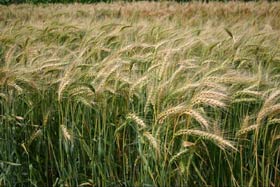
Thanks to the wheat breeding lines sent by CIMMYT, agronomists on Mauritius can screen promising wheat lines for high grain yield, early maturity, resistance to major pests and diseases, and good baking characteristics; assess wheat’s economic feasibility under local conditions; identify the main constraints to production and devise corrective measures; and conserve their own elite germplasm (seeds and genetic material).
“Based on whatever results the agronomists from Mauritius send us, we can send them more lines from CIMMYT’s wheat germplasm bank and international nurseries,” says Payne. “These lines will have much broader genetic variation and will be even better suited for the island.”
Homegrown wheat could be within reach
For now, growing wheat in Mauritius is still in the early stages; sowing, weeding, harvesting, threshing and winnowing were done manually at Réduit Crop Research Station. One of the next steps will be to research the economic viability of growing and processing wheat using mechanization which will be tested on a much larger scale, possibly with interested farmers in 2009, according to Gungadurdoss.
“Once the economic feasibility is determined, we can decide on our future move: maybe large-scale production in line with cross border initiatives with Madagascar or Mozambique to substitute part of our imports can be considered.”
“I think Mauritius gets enough rainfall for wheat, and it’s on roughly the same latitude as countries or regions that get good yields, such as Uruguay, Zimbabwe, and northern Mexico, so high wheat yields should definitely be possible,” says Hans-Joachim Braun, Director of CIMMYT’s Global Wheat Program.
For more information: Tom Payne, Head, Wheat Germplasm Bank (t.payne@cgiar.org)
More stories on agriculture in Mauritius (both in French)
Mala Gungadurdoss (Areu) : «Du riz et du blé Made in Mauritius, c’est possible»
Le blé made in Mauritius bientôt à portée de bouche
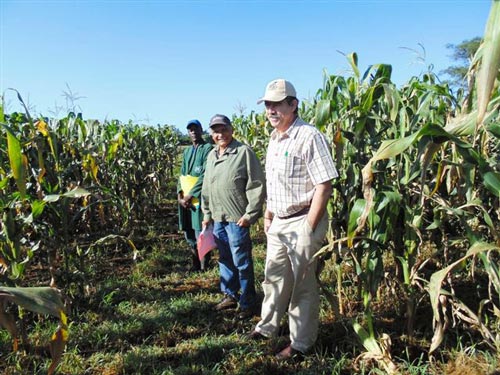 Strengthening and enhancing seed systems is critical to ensure that released varieties reach the ultimate beneficiary — the farmer, and that farmers, especially smallholders, are able to access improved maize seed varieties from seed companies who are often key players in the maize value chain. This is why scientists working on seed systems at CIMMYT met with seed companies at the Uganda Seed Trade Association (USTA) meeting during 19-20 September 2012 in Kampala, Uganda. CIMMYT was represented by seed system specialists John MacRobert and Mosisa Worku, whose objective was to create awareness on new drought tolerant (DT) maize varieties and roadmaps for their seed production. The meeting was attended by 12 participants representing 9 seed companies, along with representatives from USTA.
Strengthening and enhancing seed systems is critical to ensure that released varieties reach the ultimate beneficiary — the farmer, and that farmers, especially smallholders, are able to access improved maize seed varieties from seed companies who are often key players in the maize value chain. This is why scientists working on seed systems at CIMMYT met with seed companies at the Uganda Seed Trade Association (USTA) meeting during 19-20 September 2012 in Kampala, Uganda. CIMMYT was represented by seed system specialists John MacRobert and Mosisa Worku, whose objective was to create awareness on new drought tolerant (DT) maize varieties and roadmaps for their seed production. The meeting was attended by 12 participants representing 9 seed companies, along with representatives from USTA.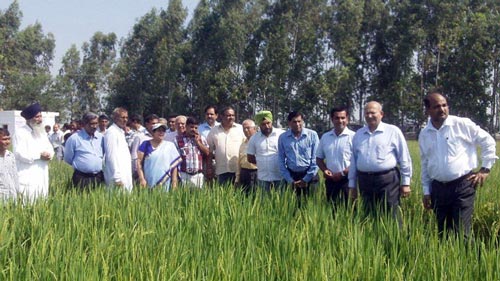 While cereal production in India has increased significantly since the mid-1960s as a result of the Green Revolution, securing the gains achieved is becoming more difficult in the context of soaring food and fuel prices, volatile markets, depleting water resources, soil degradation, and the effects of global climate change. To discuss strategies for improving efficiency and resilience of farming systems as a way to ensure sustainable food security, over 400 participants gathered for an in-field stakeholder meeting on ‘Empowering Farmers for Climate Smart Agricultural Practices in Haryana’ in Taraori, Karnal, India, on 28 September 2012. The event was organized by the CGIAR Research Program on Climate Change, Agriculture and Food Security (
While cereal production in India has increased significantly since the mid-1960s as a result of the Green Revolution, securing the gains achieved is becoming more difficult in the context of soaring food and fuel prices, volatile markets, depleting water resources, soil degradation, and the effects of global climate change. To discuss strategies for improving efficiency and resilience of farming systems as a way to ensure sustainable food security, over 400 participants gathered for an in-field stakeholder meeting on ‘Empowering Farmers for Climate Smart Agricultural Practices in Haryana’ in Taraori, Karnal, India, on 28 September 2012. The event was organized by the CGIAR Research Program on Climate Change, Agriculture and Food Security (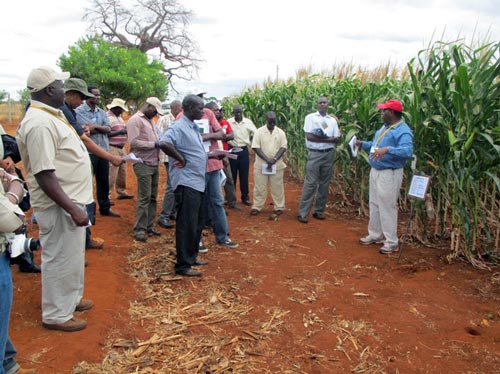 Twenty-nine drought-tolerant, early maturing, disease-resistant hybrids developed by the Water Efficient Maize for Africa (WEMA) project are getting ready to be released, a huge success for WEMA and all its stakeholders. “The 29 hybrids advanced to national performance trials is a record release by an entity in Africa in all times. These high performing hybrids yield 20–35 % more grain under moderate drought compared to 2008 commercially available hybrids,” said Stephen Mugo, CIMMYT principal scientist and co-chair of the WEMA Product Development Team. “Let us seize the technological opportunities that are there to boost productivity and people’s welfare,” he added. The white hybrids resistant to stem borers, maize weevils, and large grain borer, and to diseases such as grey leaf spot, northern leaf blight, and maize streak virus will complement other drought tolerant hybrids developed and released by the Drought Tolerant Maize for Africa (
Twenty-nine drought-tolerant, early maturing, disease-resistant hybrids developed by the Water Efficient Maize for Africa (WEMA) project are getting ready to be released, a huge success for WEMA and all its stakeholders. “The 29 hybrids advanced to national performance trials is a record release by an entity in Africa in all times. These high performing hybrids yield 20–35 % more grain under moderate drought compared to 2008 commercially available hybrids,” said Stephen Mugo, CIMMYT principal scientist and co-chair of the WEMA Product Development Team. “Let us seize the technological opportunities that are there to boost productivity and people’s welfare,” he added. The white hybrids resistant to stem borers, maize weevils, and large grain borer, and to diseases such as grey leaf spot, northern leaf blight, and maize streak virus will complement other drought tolerant hybrids developed and released by the Drought Tolerant Maize for Africa (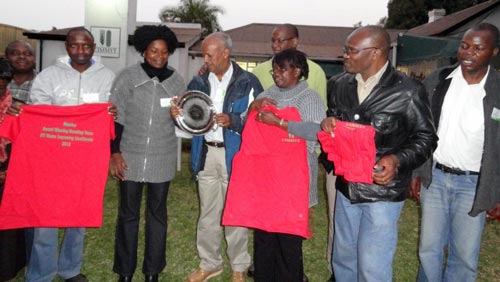 Maize plays a pivotal role in the livelihoods of people in southern Africa: its annual per capita consumption is around 85 kg. In the past season, however, farmers in Angola, Botswana, Lesotho, Swaziland, and much of Zimbabwe experienced a severe drought that significantly reduced their harvests.
Maize plays a pivotal role in the livelihoods of people in southern Africa: its annual per capita consumption is around 85 kg. In the past season, however, farmers in Angola, Botswana, Lesotho, Swaziland, and much of Zimbabwe experienced a severe drought that significantly reduced their harvests.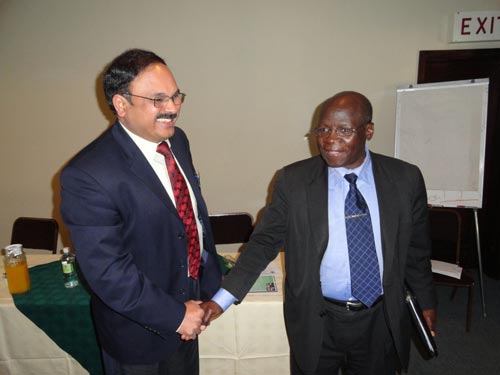 Participants discussed some of their notable achievements from 2011-12. Angola began its first commercial-scale production of the drought tolerant hybrid seed with Agropequária Kambondo and produced significant quantities of the drought tolerant openpollinated variety (OPV) ZM523. Farmers in the Democratic Republic of the Congo produced 80 tons of the drought tolerant OPV ZM623 through community-based seed schemes. Lesotho released a quality protein maize variety, and Zambia’s national program made significant progress in breeding for drought tolerance. Local emerging seed companies in Mozambique have begun production of one drought tolerant OPV and three drought tolerant hybrids.
Participants discussed some of their notable achievements from 2011-12. Angola began its first commercial-scale production of the drought tolerant hybrid seed with Agropequária Kambondo and produced significant quantities of the drought tolerant openpollinated variety (OPV) ZM523. Farmers in the Democratic Republic of the Congo produced 80 tons of the drought tolerant OPV ZM623 through community-based seed schemes. Lesotho released a quality protein maize variety, and Zambia’s national program made significant progress in breeding for drought tolerance. Local emerging seed companies in Mozambique have begun production of one drought tolerant OPV and three drought tolerant hybrids.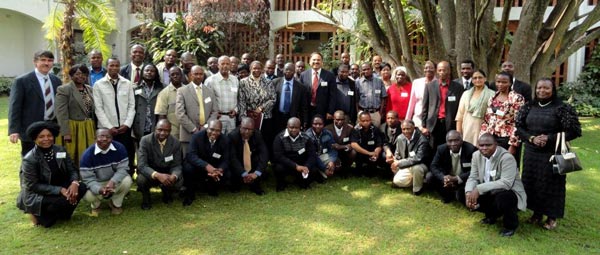
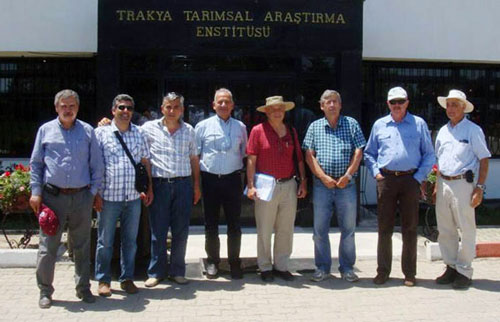 The
The 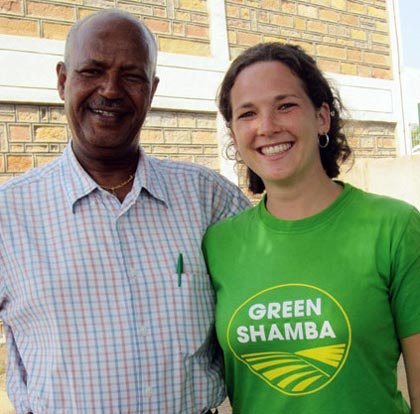 On 12 June 2012, the Drought Tolerant Maize in Africa (DTMA) project leader, Tsedeke Abate, led a group from CIMMYT in a farmer field day organized by the non-governmental organization “
On 12 June 2012, the Drought Tolerant Maize in Africa (DTMA) project leader, Tsedeke Abate, led a group from CIMMYT in a farmer field day organized by the non-governmental organization “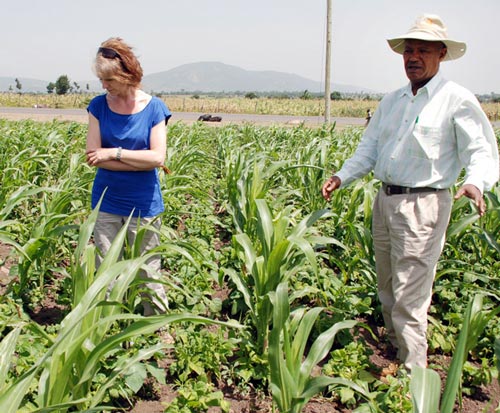 While highlighting that the work she was doing was still ongoing, Diana pointed out key strengths of the DTMA project from her assessment. “DTMA and all project personnel recognize the need to do this because it is generally acknowledged that approximately 70 percent of agricultural labor in sub-Saharan countries is provided by women,” says Diana. “Since women also play a central role in the welfare of household members and the community, understanding how drought tolerant technologies affect them is crucial to defining the impact of DTMA on poor farmers. Amongst many of the research counterparts, both public and private, there is recognition of the significance of women in agricultural systems,” she observes.
While highlighting that the work she was doing was still ongoing, Diana pointed out key strengths of the DTMA project from her assessment. “DTMA and all project personnel recognize the need to do this because it is generally acknowledged that approximately 70 percent of agricultural labor in sub-Saharan countries is provided by women,” says Diana. “Since women also play a central role in the welfare of household members and the community, understanding how drought tolerant technologies affect them is crucial to defining the impact of DTMA on poor farmers. Amongst many of the research counterparts, both public and private, there is recognition of the significance of women in agricultural systems,” she observes.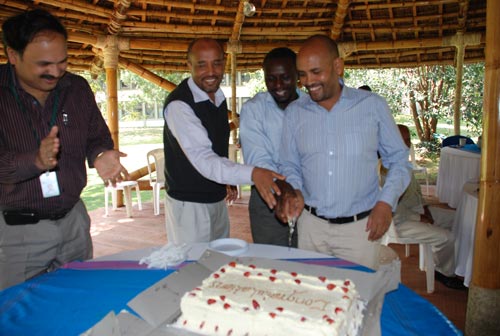 To share the good news, the Socioeconomics program hosted a get-together with the team in Nairobi, Kenya. During the cake cutting ceremony, the best gender paper award was dedicated to women farmers from Embu and Kakamega in Kenya’s Eastern and Western Provinces, where the data was collected. The Nairobi team also took the opportunity to initiate monthly seminars in order to share research findings hosted by the Global Maize Program and the Socioeconomics program and promote regular interaction among the team. The program directors, Bekele Shiferaw and B. M. Prasanna nominated Dan Makumbi, Hugo De Groote, Sika Gbegbelegbe, Fred Kanampiu, and Sarah Kibera, to form the organizing committee for the seminars.
To share the good news, the Socioeconomics program hosted a get-together with the team in Nairobi, Kenya. During the cake cutting ceremony, the best gender paper award was dedicated to women farmers from Embu and Kakamega in Kenya’s Eastern and Western Provinces, where the data was collected. The Nairobi team also took the opportunity to initiate monthly seminars in order to share research findings hosted by the Global Maize Program and the Socioeconomics program and promote regular interaction among the team. The program directors, Bekele Shiferaw and B. M. Prasanna nominated Dan Makumbi, Hugo De Groote, Sika Gbegbelegbe, Fred Kanampiu, and Sarah Kibera, to form the organizing committee for the seminars.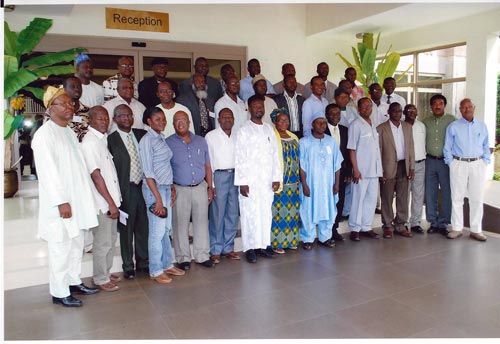 The Regional Planning Meeting for phase III of the Drought Tolerant Maize for Africa (DTMA) project was held in Kumasi, Ghana, during the week of 16-19 April 2012. The objectives of this meeting were to (i) review and document progress on DTMA project activities conducted in West Africa in 2011, (ii) present, critically review, and approve project proposals submitted for funding by partner countries Benin Republic, Ghana, Mali, and Nigeria under phase III, and develop work plans for the 2012 cropping season. The regional meetings have proved instrumental in planning and monitoring of DTMA project activities and building the requisite partnerships for successful implementation of the project.
The Regional Planning Meeting for phase III of the Drought Tolerant Maize for Africa (DTMA) project was held in Kumasi, Ghana, during the week of 16-19 April 2012. The objectives of this meeting were to (i) review and document progress on DTMA project activities conducted in West Africa in 2011, (ii) present, critically review, and approve project proposals submitted for funding by partner countries Benin Republic, Ghana, Mali, and Nigeria under phase III, and develop work plans for the 2012 cropping season. The regional meetings have proved instrumental in planning and monitoring of DTMA project activities and building the requisite partnerships for successful implementation of the project.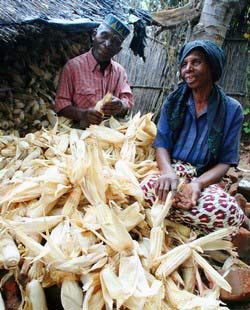 “The climate is changing, rainfall is decreasing and the weather is now dictating which varieties farmers grow and in turn which varieties seed companies produce,” says Dellings Phiri, general manager of Seed Co. Malawi, a leading southern African seed company.
“The climate is changing, rainfall is decreasing and the weather is now dictating which varieties farmers grow and in turn which varieties seed companies produce,” says Dellings Phiri, general manager of Seed Co. Malawi, a leading southern African seed company.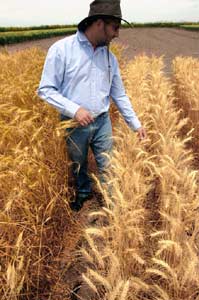 Centuries ago, Spanish monks brought wheat to Mexico to use in Roman Catholic religious ceremonies. The genetic heritage of some of these “sacramental wheats” lives on in farmers’ fields. CIMMYT researchers have led the way in collecting and characterizing these first wheats, preserving their biodiversity and using them as sources of traits like disease resistance and drought tolerance.
Centuries ago, Spanish monks brought wheat to Mexico to use in Roman Catholic religious ceremonies. The genetic heritage of some of these “sacramental wheats” lives on in farmers’ fields. CIMMYT researchers have led the way in collecting and characterizing these first wheats, preserving their biodiversity and using them as sources of traits like disease resistance and drought tolerance.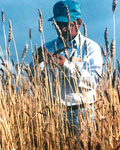
 As the price of wheat goes up, countries such as the Republic of Mauritius are feeling the pinch. A former British colony off the coast of Madagascar, it imports most of its wheat from France and Australia. But with help from CIMMYT, the island has started trials to grow its own wheat—and results to date look promising.
As the price of wheat goes up, countries such as the Republic of Mauritius are feeling the pinch. A former British colony off the coast of Madagascar, it imports most of its wheat from France and Australia. But with help from CIMMYT, the island has started trials to grow its own wheat—and results to date look promising.